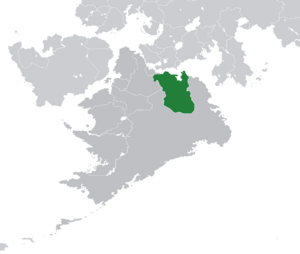Khemri
Rightly Guided State of Khemri Kahi Chimōit Thēmi Khēmi | |
|---|---|
| Motto: "Ra-Ahi" "Age of the Sun" | |
| Anthem: Sedjed Ra-Netjer "March of of the Sun's Order" | |
 Location of Khemri (green) in Majula (grey). | |
| Capital and largest city | Nekhrish |
| Official languages | High Khemric |
| Recognised national languages | Low Khemric |
| Religion | Irsad |
| Demonym(s) | Khemric |
| Government | Unitary Muist theocratic presidential Irsadic republic |
| Ese Shenudah | |
| Menes Botross | |
| Psote Ramessu | |
| Ahmose Tepio | |
| Legislature | Rightly Guided Convocation |
| Council of Experts | |
| Consultative Assembly | |
| Establishment | |
• First dynasty | 3100 BCE |
• Midrasian protectorate | 1859 CE |
• Independence | 6 March 1956 |
| 22 December 1977 | |
| Area | |
• Total | 1,148,424 km2 (443,409 sq mi) |
• Water (%) | 1.57 |
| Population | |
• 2018 estimate | 72,676,817 |
• 2016 census | 71,523,019 |
| GDP (PPP) | 2016 estimate |
• Total | $1.52 trillion |
• Per capita | $21,182 |
| GDP (nominal) | 2016 estimate |
• Total | $1.31 trillion |
• Per capita | $18,348 |
| Gini (2016) | medium |
| HDI (2016) | high |
| Currency | Nebu (KHN) |
| Time zone | UTC+2 (KNT, Khemri National Time) |
| Date format | yyyy-mm-dd (CE) |
| Driving side | right |
| Calling code | +77 |
| ISO 3166 code | KHM |
| Internet TLD | .kh |
Khemri (High Khemric: Khēmi), officially the Rightly Guided State of Khemri (High Khemric: Kahi Chimōit Thēmi Khēmi) is a unitary Muist theocratic presidential Irsadic republic in Majula. The country maintains a population of 71 million, and spans approximately 1,148,424 square kilometres (443,409 sq mi). It borders the Decanian Sea to the north, Fahran to the northwest, Habasha to the west and Kadaria to the east. Nekhrish is the capital and largest city. The current Supreme Leader is Ese Shenudah.
Considered a cradle of civilisation, Khemri emerged as one of the world's earliest civilizations, with a number of significant polities emerging in the fertile Pharaway river valley, eventually coalescing into a populous empire under the old dynasties around 3100 BCE. Ancient Khemri acted as a major power in the Decanian region, until around 1150 BCE when the entire polity collapsed and largely vanished from records. Following the collapse, the Low Khemrians migrated from the upper Pharaway, interbred with the remaining Old Khemrians and established the semi-mythical Horus Dynasty, adopting the ancient Khemric language and effectively resurrecting the ancient Khemric civilisation. While the Horus Dynasty would be usurped, Khemri itself would continue a cycle of expansion, fracturing and reunification. From 303 to 769 CE, the Iteru Dynasty presided over a recovering cultural, military and technological power, although their rule was tarnished by religious conflict, and ultimately ended by the invasion of nomadic Kodeshi groups, who brought the Irsadic religion and established the subsequent Aýnid Dynasty, which ruled until it's overthrow in 891 CE.
The overthrow of the Aýnids ushered in an era of intense of civil conflict, warlordism and disputed rule known as the Warring Kingdoms period, which would last until 1019, when the victorious Belthōn Dynasty emerged as the sole power in Khemri. The new dynasty presided over a peaceful and recovering nation, though often struggling to recapture past glories. Successive Pharaohs would seek out vanity projects in attempts to eclipse their ancestors, which in reality did nothing more than impoverish the country. Despite a brief revival initiated by the Psamtik Dynasty starting in the 1600s, the country entered a period of decline and irrelevance. By 1859, the Pharaohs had essentially surrendered sovereignty to the Midrasian Empire, with Khemri functioning as a protectorate.
Regaining full independence in 1956, Khemri emerged as a semi-constitutional monarchy within the Mydramonde. Due to Midrasian investment and wide economic deregulation, the country experienced a great deal of economic growth, and living standards rose rapidly. Despite this, the ruling government became increasingly unpopular, oppressive and corrupt, and was seen as beholden to Asuran interests. This resulted in the unexpected 1977 Revolution led by Akhtet Mu, which brought the dynastic system to an end and established an anti-Asuran republic based on Irsadist, socialist and nationalist principles. Under Muist rule, the country saw a geopolitical realignment and continued economic growth, combined with controversial social engineering and a mixed human rights record. Since the 1990s, Khemri has adopted an increasingly conciliatory outlook, shadowed by rising social liberalism.
The country maintains a GDP PPP per capita of $21,182, and a total GDP PPP of $1.94 trillion, the country is home to a wealth of mineral riches, and has arisen as a significant exporter of goods. It is considered a newly industrialized country. Characterized as one of Majula's leading regional powers, Khemri is considered a key member of the Universal Irsadic Cooperative Congress, and is an observer in the Community of Majulan Nations and the Mydramonde, while maintaining a significant standing army.

